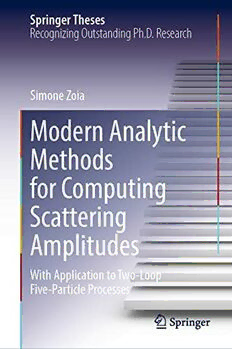
Modern Analytic Methods for Computing Scattering Amplitudes: With Application to Two-Loop Five-Particle Processes PDF
Preview Modern Analytic Methods for Computing Scattering Amplitudes: With Application to Two-Loop Five-Particle Processes
Springer Theses Recognizing Outstanding Ph.D. Research Simone Zoia Modern Analytic Methods for Computing Scattering Amplitudes With Application to Two-Loop Five-Particle Processes Springer Theses Recognizing Outstanding Ph.D. Research AimsandScope The series “Springer Theses” brings together a selection of the very best Ph.D. theses from around the world and across the physical sciences. Nominated and endorsed by two recognized specialists, each published volume has been selected foritsscientificexcellenceandthehighimpactofitscontentsforthepertinentfield of research. For greater accessibility to non-specialists, the published versions includeanextendedintroduction,aswellasaforewordbythestudent’ssupervisor explainingthespecialrelevanceoftheworkforthefield.Asawhole,theserieswill provide a valuable resource both for newcomers to the research fields described, and for other scientists seeking detailed background information on special questions. Finally, it provides an accredited documentation of the valuable contributionsmadebytoday’syoungergenerationofscientists. Theses may be nominated for publication in this series by heads of department at internationally leading universities or institutes andshouldfulfillallofthefollowingcriteria • TheymustbewritteningoodEnglish. • ThetopicshouldfallwithintheconfinesofChemistry,Physics,EarthSciences, EngineeringandrelatedinterdisciplinaryfieldssuchasMaterials,Nanoscience, ChemicalEngineering,ComplexSystemsandBiophysics. • Theworkreportedinthethesismustrepresentasignificantscientificadvance. • Ifthethesisincludespreviouslypublishedmaterial,permissiontoreproducethis mustbegainedfromtherespectivecopyrightholder(amaximum30%ofthethesis shouldbeaverbatimreproductionfromtheauthor’spreviouspublications). • They must have been examined and passed during the 12 months prior to nomination. • Each thesis should include a foreword by the supervisor outlining the signifi- canceofitscontent. • The theses should have a clearly defined structure including an introduction accessibletonewPhDstudentsandscientistsnotexpertintherelevantfield. IndexedbyzbMATH. Moreinformationaboutthisseriesathttps://link.springer.com/bookseries/8790 Simone Zoia Modern Analytic Methods for Computing Scattering Amplitudes With Application to Two-Loop Five-Particle Processes Doctoral Thesis accepted by Ludwig-Maximilians-Universität München, Germany Author Supervisor Dr.SimoneZoia Prof.JohannesM.Henn DepartmentofPhysics Werner-Heisenberg-Institut UniversityofTurin Max-Planck-InstitutfürPhysik Turin,Italy München,Germany ISSN 2190-5053 ISSN 2190-5061 (electronic) SpringerTheses ISBN 978-3-031-01944-9 ISBN 978-3-031-01945-6 (eBook) https://doi.org/10.1007/978-3-031-01945-6 ©TheEditor(s)(ifapplicable)andTheAuthor(s),underexclusivelicensetoSpringerNature SwitzerlandAG2022 Thisworkissubjecttocopyright.AllrightsaresolelyandexclusivelylicensedbythePublisher,whether thewholeorpartofthematerialisconcerned,specificallytherightsoftranslation,reprinting,reuse ofillustrations,recitation,broadcasting,reproductiononmicrofilmsorinanyotherphysicalway,and transmissionorinformationstorageandretrieval,electronicadaptation,computersoftware,orbysimilar ordissimilarmethodologynowknownorhereafterdeveloped. Theuseofgeneraldescriptivenames,registerednames,trademarks,servicemarks,etc.inthispublication doesnotimply,evenintheabsenceofaspecificstatement,thatsuchnamesareexemptfromtherelevant protectivelawsandregulationsandthereforefreeforgeneraluse. Thepublisher,theauthorsandtheeditorsaresafetoassumethattheadviceandinformationinthisbook arebelievedtobetrueandaccurateatthedateofpublication.Neitherthepublishernortheauthorsor theeditorsgiveawarranty,expressedorimplied,withrespecttothematerialcontainedhereinorforany errorsoromissionsthatmayhavebeenmade.Thepublisherremainsneutralwithregardtojurisdictional claimsinpublishedmapsandinstitutionalaffiliations. ThisSpringerimprintispublishedbytheregisteredcompanySpringerNatureSwitzerlandAG Theregisteredcompanyaddressis:Gewerbestrasse11,6330Cham,Switzerland Supervisor’s Foreword Ourabilitytounderstandthefundamentallawsoftheuniverserestsonthecomparison betweentheoryandexperiments.Scatteringamplitudesarewhatmakesthispossible forthequantumfieldtheoriesdescribingelementaryparticlesandtheirinteractions. Theircomputationtoeverincreasingaccuracyisoftheutmostimportance.Simone Zoia’sthesisoffersinsightintothedramaticprogressthefieldofscatteringampli- tudes has undergone in the last years. We now understand much better the special functions appearing in the scattering amplitudes, in particular thanks to a deeper understandingofthedifferentialequationssatisfiedbytheloopFeynmanintegrals. Thisdevelopmentwasrecentlycomplementedbytheapplicationoffinitefieldarith- metics, which allows us to handle efficiently the complicated multivariate rational functionsappearingalongwiththespecialfunctionsinthescatteringamplitudes.This isespeciallyrelevantforprocessesinvolvingmanykinematicalscales,whichareof particularinterestforphenomenologicalapplications.Thesetwotoolsconstitutethe backboneofthemodernworkflowforcomputingscatteringamplitudespresentedin thisthesis. This thesis is useful for master and Ph.D. students, as well as researchers who would like to get acquainted with the latest methods and results. Starting from a basicknowledgeofquantumfieldtheory,Dr.Zoiagivesapedagogicalreviewofthe basicnotionsofscatteringamplitudes,andsmoothlymovesontopresentingsome ofthemostadvancedtechniquesfortheircomputation.Thediscussionisthorough yet concise, enriched with interesting explicit examples, and culminates with the applicationtoaproblemofgreatrelevanceforthephysicsprogramofCERN’sLarge HadronCollider:thecomputationoffive-particlescatteringamplitudesattwo-loop order.Theworkpresentedinthisthesisconstitutesanimportantstepforwardinthe field,andcontributessignificantlytomakingfive-particleprocessesattwo-looporder thenewstateoftheartforscatteringamplitudesintheStandardModelofParticle Physics. The techniques and the results discussed here open the door to precision phenomenology for several processes of great interest for the LHC programme, v vi Supervisor’sForeword suchasthree-photonproduction,three-jetproduction,anddi-photonproductionin associationwithajet. München,Germany Prof.JohannesM.Henn April2022 Abstract Thescientificapproachtounderstandingthelawsofnatureisbasedonthecompar- isonbetweentheoryandexperiment.Inlaypersons’terms,atheoryisasetofrules which describe mathematically how we think things work. We use these rules to predicttheoutcomeofacertainexperiment,andthecomparisonagainsttheactual resultsoftheexperimentmaydisproveorupholdthetheory. Particlephysicsisconcernedwiththetiniestbuildingblocksoftheuniverse—the fundamental particles—and the way they interact. Our best description of funda- mentalparticlesisgivenbytheStandardModelofparticlephysics(SM),whichtreats particles as oscillations of “quantum fields” permeating the space-time. The spec- tacularsuccessoftheSMatdescribingthemicroscopicworldisoneofhumanity’s greatest intellectual feats. Yet, this theory fails to address a variety of theoretical concernsandobservedphenomena—gravity,tosaythemostobvious.Understanding thelimitationsoftheSMandconstrainingitsextensionsisofprimaryimportance. ScatteringamplitudesarethebridgebetweentheoryandexperimentsinQuantum Field Theories (QFTs). Roughly speaking, the amplitude of a scattering process encodes its probability distribution: for a given initial state—say two colliding protons—thescatteringamplitudetellsushowlikelytheproductionofcertainother particlesisaccordingtothetheory.TherulesofQFTarehowevercomplicated,and scatteringamplitudescanonlybecomputedapproximatelyasseriesinthecoupling constants which weigh the interactions. We know—at least in principle—how to compute each term of the series, and including more terms makes the prediction more accurate. The computation however becomes more and more difficult as the order in the couplings—also called the “loop order”—or the number of particles increase. In practice, we need as many terms as is necessary to make the theoret- ical uncertainty comparable with the experimental one so that the comparison is statisticallysignificant. ExploitingfullythephysicspotentialofCERN’sLargeHadronColliderrequires predictions at the Next-to-Next-to-Leading Order (NNLO) in the coupling of the stronginteractions.Thisgoalhasalreadybeenreachedformany2→1and2→2 processes.Processeswiththreeparticlesinthefinalstatearehoweverofgreatinterest, astheywouldallowforprecisemeasurementsofthestrongcouplingconstantandof vii viii Abstract itsscaling,in-depthstudiesoftheHiggscouplings,betterbackgroundestimatesfor yetunknownphenomena,andmore.ThemainbottlenecktowardsNNLOpredictions for2→3processesistheanalyticcomputationoftwo-loopfive-particlescattering amplitudes. Themostdifficultpartofcomputingascatteringamplitudeisthecomputationof theFeynmanintegralsappearinginit.MycollaboratorsandIcomputedthemissing andmostcomplicatedsetofmasslesstwo-loopfive-particleFeynmanintegrals.This opened the doors to the computation of the amplitude for any process involving fivemasslessparticlesattwo-looporder.Suchprocessesfeatureprominentlyinthe LHCphysicsprogram.Casesinpointarethree-jet,three-photon,anddi-photon+jet production.Inordertocomputetheseintegralswemadeuseofcutting-edgemathe- maticaltechniques,andproposedanewstrategywhichhasalreadybeenappliedto otherdifficultproblems. ArmedwithanalyticexpressionsfortheFeynmanintegrals,wetackledtheampli- tudes.Thechallengeisoneofenormousalgebraiccomplexity.Wedevelopedawork- flowbasedontherecentideaofevaluatingtherationalfunctionsintheintermediate expressionsnumericallyoverfinitefields.Theanalyticexpressionofthefinalresult isthenreconstructedby“bootstrapping”anAnsatzorthroughreconstructionalgo- rithms.BeforeconsideringtheSM,wetestedourapproachontheamplitudesintwo supersymmetrictheories:N =4superYang-MillstheoryandN =8supergravity. Theseweretheveryfirstcompletefive-particlescatteringamplitudestobecomputed analytically at two loops. Although these models do not seek to describe physical particlesandforces,theyareofgreatinterest.Theygivepreciousinsightsintohidden structuresofQFTingeneraland—thankstotheirsimplicityandelegance—theyare aperfecttestinggroundfornewtechniquesandideaswhichcanbelaterappliedto theSM. The successful computation of the supersymmetric amplitudes showed that our technology was mature enough to face the SM. We therefore computed the two- loopamplitudedescribingthescatteringoffivepositive-helicitygluonsinQuantum Chromodynamics (QCD), the part of the SM which describes the strong interac- tions. Despite the leap in complexity with respect to the supersymmetric theories, wemanagedtofindanextremelycompactandelegantanalyticexpression.Having compactresultsfortheamplitudesisnotonlyatheorist’sdelightbutalsoiscrucial fortheiruseinphenomenology.Thesimplicityoftheexpressionallowedustonotice thatcertainpartsoftheamplitudeenjoyanunexpectedproperty:theyareinvariant underconformalsymmetry.Weidentifiedtheoriginofthispropertyintheconformal invarianceofthegluonicamplitudesinQCDatoneloop,whichweprovedforany numberofgluons. After the publication of the results presented in this thesis, there has been a dramatic progress. Several other two-loop five-particle amplitudes have become available analytically, and this has already led to the first theoretical prediction at NNLOinQCD,forthree-photonproduction.Partlyusingmethodssimilartothose presentedinthisthesis,manymoreresultsaresuretofollowinthenearfuture. PublicationsRelatedtoThisThesis This thesis is based on the author’s work conducted at the Johannes Gutenberg UniversityinMainzfromOctober2017toSeptember2018,andattheMaxPlanck InstituteforPhysicsinMunichfromOctober2018toSeptember2020.Partsofthis workhavealreadybeenpresentedinthefollowingpublications. RefereedResearchPapers • D.Chicherin,T.Gehrmann,J.M.Henn,P.Wasser,Y.ZhangandS.Zoia,“Analytic resultforatwo-loopfive-particleamplitude,”Phys.Rev.Lett.122(2019)no.12, 121602; • D. Chicherin, T. Gehrmann, J. M. Henn, P. Wasser, Y. Zhang and S. Zoia, “All masterintegralsforthree-jetproductionatNNLO,”Phys.Rev.Lett.123(2019) no.4,041603; • D.Chicherin,T.Gehrmann,J.M.Henn,P.Wasser,Y.ZhangandS.Zoia,“The two-loopfive-particleamplitudeinN =8supergravity,”JHEP1903(2019)115; • S. Badger, D. Chicherin, T. Gehrmann, G. Heinrich, J. M. Henn, T. Peraro, P. Wasser,Y. Zhang and S. Zoia, “Analytic form of the full two-loop five-gluon all-plushelicityamplitude,”Phys.Rev.Lett.123(2019)no.7,071601; • J. M. Henn, B. Power and S. Zoia, “Conformal Invariance of the One-Loop All-PlusHelicityScatteringAmplitudes,”JHEP02(2020)019; • S. Caron-Huot, D. Chicherin, J. M. Henn, Y. Zhang and S. Zoia, “Multi-Regge Limit of the Two-Loop Five-Point Amplitudes in N = 4 Super Yang-Mills and N =8Supergravity,”JHEP10(2020)188. ConferenceProceedings • S. Zoia, “Conformal Symmetry and Feynman Integrals,” PoS LL2018 (2018) 037,basedonatalkgivenatLoopsandLegsinQuantumFieldTheory,St.Goar, Germany(2018). ix
